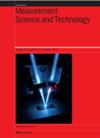Anisotropic complex permittivity measurement using a microstrip air line
IF 2.7
3区 工程技术
Q1 ENGINEERING, MULTIDISCIPLINARY
引用次数: 0
Abstract
A microstrip air line system for measuring the complex permittivity of anisotropic materials in the band from 0.3 to 1 GHz is proposed. The multireflect-thru method is used to calibrate the measurement system in the whole band with a single microstrip air line without suffering from the limited space resolution of time-gating technique. During the measurement, the material under test (MUT) is placed both above and below the strip. With this deployment, the TEM mode propagates along the microstrip in the MUT. Therefore, it is possible to measure the anisotropic permittivity. Since a small portion of the electric field is parallel to the ground plane around two edges of the strip, the extracted property is not purely along one direction. To obtain higher accuracy, with the help of linear combination, the properties along two directions are disentangled by two measurements. For validation of the method, an isotropic material and an anisotropic material in the microstrip air line were simulated and their permittivities were extracted from simulation results. An anisotropic material polytetrafluoroethylene (PTFE) and two anisotropic materials, FR4 and honeycomb absorber, were measured. The results of PTFE show that there is a maximum relative error of 1.4% and 2.5% for the permittivity extracted from simulation and measurement, respectively. The validity and the accuracy of the system for measuring anisotropic materials are verified by the simulation and measurement results.使用微带空气线测量各向异性复介电常数
本文提出了一种微带空气线系统,用于测量各向异性材料在 0.3 至 1 GHz 波段内的复介电常数。该系统采用多反射通过法,利用单根微带空气线在整个频带内校准测量系统,而不会受限于时间门控技术的空间分辨率。在测量过程中,被测材料(MUT)被置于微带的上方和下方。在这种部署下,TEM 模式会沿着 MUT 中的微带传播。因此,可以测量各向异性介电常数。由于一小部分电场平行于微带两个边缘的地平面,因此所提取的特性并非纯粹沿一个方向。为了获得更高的精度,可借助线性组合,通过两次测量将沿两个方向的特性分开。为验证该方法,模拟了微带气路中的各向同性材料和各向异性材料,并从模拟结果中提取了它们的介电常数。测量了各向异性材料聚四氟乙烯(PTFE)和两种各向异性材料(FR4 和蜂窝吸收器)。聚四氟乙烯的结果表明,模拟和测量得出的介电常数最大相对误差分别为 1.4% 和 2.5%。模拟和测量结果验证了该系统测量各向异性材料的有效性和准确性。
本文章由计算机程序翻译,如有差异,请以英文原文为准。
求助全文
约1分钟内获得全文
求助全文
来源期刊

Measurement Science and Technology
工程技术-工程:综合
CiteScore
4.30
自引率
16.70%
发文量
656
审稿时长
4.9 months
期刊介绍:
Measurement Science and Technology publishes articles on new measurement techniques and associated instrumentation. Papers that describe experiments must represent an advance in measurement science or measurement technique rather than the application of established experimental technique. Bearing in mind the multidisciplinary nature of the journal, authors must provide an introduction to their work that makes clear the novelty, significance, broader relevance of their work in a measurement context and relevance to the readership of Measurement Science and Technology. All submitted articles should contain consideration of the uncertainty, precision and/or accuracy of the measurements presented.
Subject coverage includes the theory, practice and application of measurement in physics, chemistry, engineering and the environmental and life sciences from inception to commercial exploitation. Publications in the journal should emphasize the novelty of reported methods, characterize them and demonstrate their performance using examples or applications.
 求助内容:
求助内容: 应助结果提醒方式:
应助结果提醒方式:


